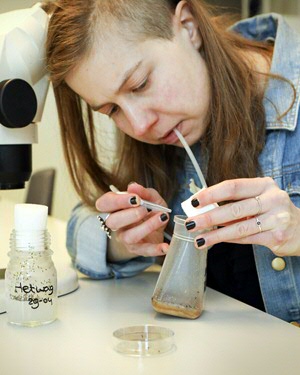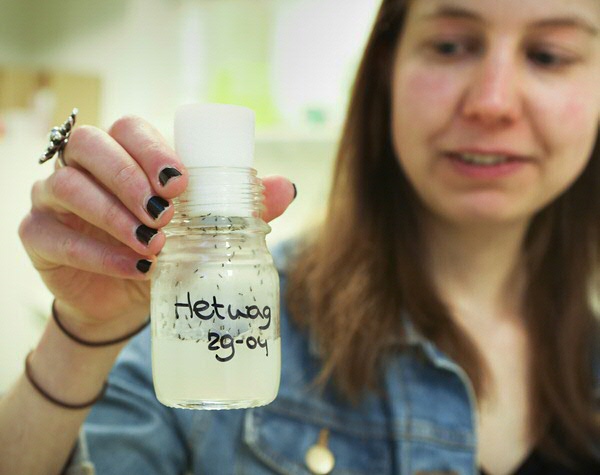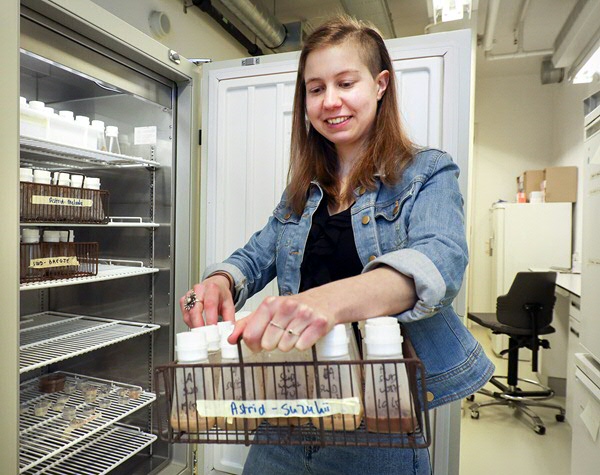How Darwin offers an alternative for pesticides

Pesticides can protect crops against harmful invaders, but they can also be very damaging to nature. Unfortunately, there are not always good environmentally-friendly alternatives. The deployment of the natural enemies of pests could offer a solution. For my PhD research, I am studying how we could improve natural enemies for biological crop protection.
By: Astrid Kruitwagen / Photos: Henk veenstra
Finding the right enemy
One of the big challenges is to find an enemy that has the exact combination of characteristics to efficiently find and kill pests in crops. This is especially difficult when the types of pests are new, as existing enemies are not always effective. Usually, various species are tested to eventually find an enemy with the right combination of characteristics. In this process, the variation between species is mainly investigated. But the interesting thing is that we know that there are also often variations within one species. Individual organisms can vary in terms of the characteristics that are crucial to stifle pests, such as hunting efficiency, reproduction pace and their killing capabilities. But what good is that knowledge?
Creating a better species
If this variation is also hereditary, you would be able to artificially select a certain species in a lab to create a hereditary line with the desired characteristics – to create a many-headed monster for the protection of our crops. An extra advantage is that we then wouldn’t be modifying any genetic material; we would be looking at how we could best make use of the genetic variation that already exists in nature.
Evolved strawberries and tomatoes
At first glance, this seems very realistic. The proof that evolution can be used to change organisms in line with our human preference can be found quickly. Just look at the fruit and vegetable section in the supermarket: all the result of centuries-long plant breeding. Would we also be able to do this to improve natural enemies for crop protection?

The fruit fly: small, harmful and strong
As part of my research, I am focusing on biological control against the spotted wing drosophila (SWD) fruit fly (Latin name: Drosophilia suzukii): an exotic species that arrived in the Netherlands some 10 years ago, bringing with it great damage to soft fruit such as cherries, blueberries, raspberries, strawberries and grapes. Parasitoid wasps should be able to offer resistance against these pests by parasitizing them. But there seems to be one substantial problem: the SWD fruit fly has an enormously high resilience. Most indigenous parasitoid wasps are no match for this, so the flies are able to escape their enemies and carry on without disruption.
A new parasitoid wasp
To find a suitable species of parasitoid wasp, we first carried out an extensive literature study and lab experiments. As a result, we landed on a species that generally appears in the Netherlands and is distinguished by the Latin name Leptopilina heterotoma. In contrast to most other types of parasitoid wasp, this species appears to be able to parasitize the SWD fruit fly to a certain extent. But this was still not sufficient to be able to deploy them as a biological controller. That’s why we started a large-scale study to see whether we could select a new, efficient hereditary line of parasitoid wasps.
Variation and heredity
To do this, we needed insight into two fundamental conditions of evolution: variation and heredity. In other words, do individual parasitoid wasps vary among one another? And to what extent is their behaviour genetically determined? Insight into these fundamental biological questions is essential for reaching an application: to further develop the selection method for optimization of biological control.
‘Fridges’ full of wasps
In the lab located on the sixth floor of the Linnaeusborg at Zernike Campus stand a number of large ‘incubators’: large cupboards that, at first sight, look like fridges. For this study, we gathered and cultivated all sorts of parasitoid wasps from the Netherlands, Spain and France in these incubators. In addition to the parasitoid wasps, we also cultivated the flies against which the wasps would be selected. The ‘enemy’ and its ‘victim’ were housed right next to one another, separated by the incubator walls, and seemed to have fully surrendered to humans.

Favorable omens
By means of behavioural experiments in the lab, we were able to demonstrate that significant differences exist between European populations in terms of their capabilities for parasitizing the SWD fruit fly. This is good news because this variation is the first condition of evolution. Next, we cross-bred these populations to make an estimation, based on their relatedness, of the extent to which these differences are also genuinely hereditary. The result was clear: the efficiency in which parasitoid wasps can parasitize the SWD fruit fly is partially genetically determined. So, through this process, we also satisfied the second condition of evolution (heredity) and thus, in theory, we could expect that the parasitoid wasps can be artificially selected.
Humans cannot control everything
For one year, I worked in the lab to see whether we could select the parasitoid wasps to make them stronger in parasitizing the SWD fruit fly. Generation to generation, I compared many parasitoid wasps to one another, and then selected and cross-bred the best wasps. Evolution in the lab! The outcomes of the study were not exactly what we had expected at the start. After a year of selection, there did not seem to be a significant improvement in parasitism. From the greenhouse trials, it appeared that the selected parasitoid wasps were not sufficient for use as biological controllers. This means that with the outcomes of this study, we still do not have a direct application to offer fruit growers in the fight against the SWD pest. The creatures in the lab apparently will not simply allow humans to control them, despite all of our scientific insights.
Was this the right method?
You could therefore ask yourself whether artificial selection is indeed a good method for improving biological control. But, with the knowledge that we gained during this study, we can improve this method to be able to select natural enemies more efficiently in the future. Still, there is perhaps one factor that should not be underestimated.
More time needed
Alongside variation and heredity, there is yet a third ingredient necessary for artificial selection: time. Evolution needs time. Looking back at the history of the strawberry, bell pepper, tomato and cucumber, it is clear that these crops were also not selected in one year. Time is necessary to try things out, to find the right genetic variation, to cross-breed organisms and to give room for chance. The selection of natural enemies therefore does not always seem to provide a direct solution, but does have potential for optimizing biological control in the future – in any case, if the basic ingredients can be guaranteed.
This article was created in collaboration with MindMint.
More information
- Astrid Kruitwagen, a.j.kruitwagen@rug.nl
- The results of this study have been published in the journal Evolutionary Applications
More news
-
15 September 2025
Successful visit to the UG by Rector of Institut Teknologi Bandung
